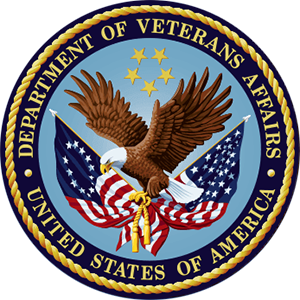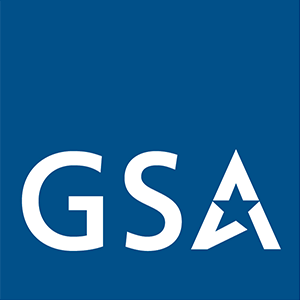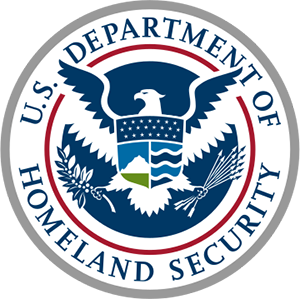Overview
Within This Page
For Americans with disabilities, access means simply being able to use, enjoy, and participate in the many aspects of society, including work, commerce, and leisure activities. While removing architectural barriers may allow people with disabilities to circulate within and around a facility, other factors, such as transportation, affect their ability to fully participate in activities. Designers and other suppliers of services and goods need to provide equal access for all without undermining the needs of people with disabilities.

Access can be seamless even at historic buildings. Photo courtesy of the U.S. General Services Administration
What is "Equal Access"?
Providing equal access means ensuring all individuals can make use of transportation, buildings and facilities, programs and services, employment opportunities, and technology. It also means offering all users the same provisions for privacy, security, and safety.
Design professionals can promote equal access by incorporating and integrating accessible and universal design features in a building's design program. Providing equal access begins at the programming and planning phase of a project and requires buy-in from all stakeholders involved in the project. Critical decisions are made during the initial programming and planning phase of a project which can greatly impact the cost of providing equal access and in some cases affect whether or not equal access can be achieved. For instance, a building's orientation on a site can affect whether the installation of a ramp is necessary to access the entrance. All design professionals must be aware of the accessibility requirements that apply to the project. Design professionals may benefit from the assistance of consultants specializing in accessibility requirements.
Knowledgeable and detail oriented contractors are key to ensuring that equal access is achieved during the construction phase. If the contractor is not knowledgeable about constructing accessible features equal access may be compromised. In many instances, whether equal access is achieved during the construction process is dependent on a contractor's installation techniques. For example, an accessible threshold designed to be a maximum of ½" high is typically installed with a sealer beneath which, if not installed properly, can result in a constructed threshold which is more than ½" high.
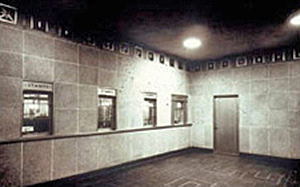
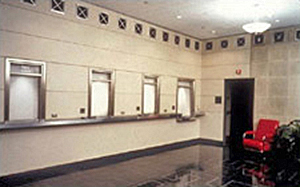
The renovated Post Office at Ronald Reagan National Airport provides equal access to the intake windows, Arlington, VA. Note the accessible window on the far right. Photos before and after the renovation by: Eric Taylor on behalf of the Metropolitan Washington Airports Authority
Why Provide "Equal Access"?
Providing equal access removes discrimination and protects human rights. An accessible built environment provides the opportunity for all people to fully participate in and contribute to their families, communities, and society. Equal access offers individuals the occasion to improve the quality of life and standard of living for themselves, their families, and other people in the world. Finally, providing equal access is required, to varying degrees, in order to meet applicable building codes, accessibility standards, and accessibility guidelines.
How Do We Achieve "Equal Access"?
Equal access must be an integral part of the life-cycle process not an afterthought during:
- planning,
- programming,
- design,
- construction,
- operations and maintenance (including staff training) of buildings and facilities.
Accessible features should blend seamlessly with the design. All stakeholders on the project should work together from the start to coordinate and optimize the design of the site and the building. A building and its site should be designed as an integrated whole, rather than as a collection of isolated systems (see also WBDG Functional—Ensure Appropriate Product/Systems Integration).
Design and construction decisions impact accessibility. Single building elements or systems should not be added, deleted, or modified anytime in the life of the building until they are coordinated and evaluated with the other elements and systems in the whole building package and with all parties involved.
Keep in mind that "equal access" applies to programs, services, benefits, transportation, fixtures, furnishings, equipment, employment opportunities, and technology. The Rehabilitation Act of 1973 prohibits discrimination on the basis of disability in aspects of all programs conducted by Federal agencies, in programs receiving Federal financial assistance, in Federal employment, in the employment practices of Federal contractors, and in Federal procurement practices.
Relevant Codes, Standards, Laws, and Guidelines
Codes and Standards
- ASME A17.1/CSA B44 Handbook on Safety Code for Elevators and Escalators
- ASME A18.1 Safety Standard for Platform Lifts and Stairway Chairlifts
- International Code Council (ICC)—ICC is the secretariat for the following:
- National Fire Protection Association (NFPA)
- Uniform Federal Accessibility Standards
Guidelines
Americans with Disabilities Act and Architectural Barriers Act Accessibility Guidelines for Buildings and Facilities—This document contains scoping and technical requirements for accessibility to sites, facilities, buildings, and elements by individuals with disabilities. The requirements are to be applied during the design, construction, additions to, and alteration of sites, facilities, buildings, and elements to the extent required by regulations issued by Federal agencies under the Americans with Disabilities Act of 1990 (ADA).
Fair Housing Accessibility Guidelines—This document presents guidelines adopted by the Department of Housing and Urban Development to provide builders and developers with technical guidance on how to comply with the specific accessibility requirements of the Fair Housing Amendments Act of 1988. Issuance of this document follows consideration of public comment received on proposed accessibility guidelines published in the Federal Register on June 15, 1990. The guidelines presented in this document are intended to provide technical guidance only, and are not mandatory.
- Guide to the ADA Accessibility Standards—This guide explains requirements in the current editions of the ADA Standards issued by the Department of Justice (DOJ) and the Department of Transportation (DOT). It was developed by the U.S. Access Board in cooperation with DOJ and DOT. It is important to use this guide along with a complete copy of the ADA Standards as it explains, but does not contain or reprint, the text of the ADA Standards.
Laws
Americans with Disabilities Act (ADA): The ADA prohibits discrimination on the basis of disability in employment, State and local government, public accommodations, commercial facilities, transportation, and telecommunications. It also applies to the United States Congress.
Architectural Barriers Act (ABA): The Architectural Barriers Act (ABA) requires that buildings and facilities that are designed, constructed, or altered with Federal funds, or leased by a Federal agency, comply with Federal standards for physical accessibility. ABA requirements are limited to architectural standards in new and altered buildings and in newly leased facilities. They do not address the activities conducted in those buildings and facilities. Facilities of the U.S. Postal Service are covered by the ABA.
Fair Housing Amendments Act of 1988 (FHA): The Fair Housing Act, as amended in 1988, prohibits housing discrimination on the basis of race, color, religion, sex, disability, familial status, and national origin. Its coverage includes private housing, housing that receives Federal financial assistance, and State and local government housing. It is unlawful to discriminate in any aspect of selling or renting housing or to deny a dwelling to a buyer or renter because of the disability of that individual, an individual associated with the buyer or renter, or an individual who intends to live in the residence. Other covered activities include, for example, financing, zoning practices, new construction design, and advertising.
- Rehabilitation Act of 1973, Section 504 & Section 508: The Rehabilitation Act prohibits discrimination on the basis of disability in programs conducted by Federal agencies, in programs receiving Federal financial assistance, in Federal employment, and in the employment practices of Federal contractors. The standards for determining employment discrimination under the Rehabilitation Act are the same as those used in title I of the Americans with Disabilities Act.
Additional Resources
Organizations
- International Code Council (ICC)—ICC is the secretariat for the:
- International Living Future Institute, Living Building Challenge
- National Fire Protection Association (NFPA)
Federal Agencies
The major resource for guidance on accessible design is the U.S. Access Board (Access Board). The Access Board is an independent federal agency devoted to accessibility for people with disabilities. Key responsibilities of the Board include developing and maintaining accessibility requirements for the built environment, transit vehicles, telecommunications equipment, electronic and information technology, and medical diagnostic equipment providing technical assistance and training on these guidelines; and enforcing accessibility standards for federally funded facilities. For additional resources, see the Access Board's Listing of Other Resources. Animations for many accessible solutions can be found on the Animations page.

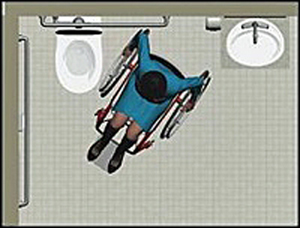
Wheelchair maneuvering, one of many animations which can be found on the U.S. Access Board's website. Image courtesy of the U.S. Access Board.
Sample Accessible Toilet Rooms animation. Image courtesy of the U.S. Access Board.
Department of Defense—ABA Accessibility Standard for DOD Facilities
Department of Housing and Urban Development (HUD) Office of Fair Housing and Equal Opportunity (FHEO)—HUD enforces the Fair Housing Act under regulations to the ABA and has issued guidelines under this law (the Fair Housing Accessibility Guidelines) which cover multi-family housing. Information is also available on how to file a complaint with HUD under the Fair Housing Act. HUD's website also addresses access under Section 504 of the Rehabilitation Act. See also HUD's Accessibility Requirements for Buildings.
Department of Justice (DOJ)—DOJ offers technical assistance on the ADA Standards for Accessible Design and other ADA provisions applying to public accommodations and commercial facilities, including businesses, nonprofit service agencies, and state and local government programs and services; also provides information on how to file ADA complaints. Many of its technical assistance letters are available online.
- ADA Information Line for documents, questions, and referrals: (800) 514-0301 (voice) (800) 514-0383 (TTY)
- Department of Veterans Affairs (VA)—Barrier-Free Design Standard
- General Services Administration (GSA)—Accessible Facility Design
- U.S. Navy—Accessibility Requirements for Navy and Marine Corps Facilities
- U.S. Park Service—Director's Order #42: Accessibility for Visitors with Disabilities in National Park Service Programs and Services
- U.S. Department of Transportation—Accessibility
- U.S. Postal Service— Handbook RE-4 Standards for Facility Accessibility
Publications
- The 1995 Accessible Building Product Guide by John P.S. Salmen and Julie Quarve-Peterson. New York, NY: John Wiley & Sons, Inc., 1995.
- Access by Design by George A. Covington and Bruce Hannah. New York, NY: John Wiley & Sons, Inc., 1996.
- The Accessible Housing Design File by Barrier Free Environments, Inc. New York, NY: John Wiley & Sons, Inc., 2010.
Others
- Building Research Information Knowledgebase(BRIK)—an interactive portal offering online access to peer-reviewed research projects and case studies in all facets of building, from predesign, design, and construction through occupancy and reuse.
Special thanks to Lex Frieden for his inspiring words in the speech "Toward a Barrier Free World for All," April 5, 2001.


